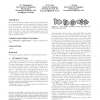981 search results - page 105 / 197 » Negation in Spatial Reasoning |
CVPR
2005
IEEE
15 years 1 months ago
2005
IEEE
We present an approach for tracking varying number of objects through both temporally and spatially significant occlusions. Our method builds on the idea of object permanence to r...
ICDE
2008
IEEE
15 years 16 days ago
2008
IEEE
The development of sensors capable of obtaining 3D scans of crime scenes is revolutionizing the ways in which crime scenes can be analyzed and at the same time is driving the need ...
GIS
2007
ACM
15 years 7 days ago
2007
ACM
We discuss the task of reconstructing the topological map of an environment based on the sequences of locations visited by a mobile agent ? this occurs in systems neuroscience, wh...
IROS
2006
IEEE
14 years 5 months ago
2006
IEEE
Abstract— Linking semantic and spatial information has become an important research area in robotics since, for robots interacting with humans and performing tasks in natural env...
CVPR
2011
IEEE
13 years 7 months ago
2011
IEEE
Detecting people remains a popular and challenging problem in computer vision. In this paper, we analyze parts-based models for person detection to determine which components of t...

